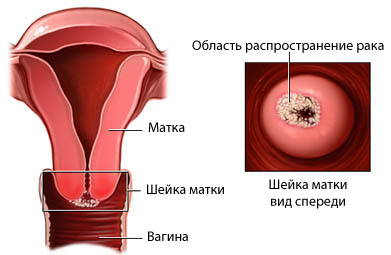Cervical cancer
Description of cervical cancer
Cervical cancer – disease, in which cancer cells grow in the cervix. Cervix – lower, narrow part of the uterus, that connects the uterus with the vagina.
Cancer occurs, when the cells of the organism (In this case, the cells of the cervix) divide uncontrollably, and formed outgrowth (weight) of cloth, called tumor. The term cancer refers to malignant tumors, that can invade nearby tissues and spread to other parts of the body. Benign tumors do not spread to other organs.

Causes of cervical cancer
Studies show, that some sexually transmitted viruses (eg, human papilloma virus) can induce changes in cell nuclei cervix, that can lead to cancer.
Risk factors for cervical cancer
Scientists have identified a number of risk factors, which can increase the likelihood of developing cervical cancer:
- Infection of the cervix with human papillomavirus (HPV) – the main risk factor for cervical cancer;
- Cervical dysplasia (a precancerous condition);
- The mother took the drug diethylstilbestrol during pregnancy;
- HIV / AIDS;
- Age: senior 25 years;
- Multiple sexual partners;
- Sexual activity before 18 years;
- The first pregnancy until the age of 20;
- Smoking.
Symptoms of Cervical Cancer
Symptoms of cervical cancer usually do not appear until, until the abnormal cells do not become cancerous and invade nearby tissue. When this happens, the most common symptoms are abnormal bleeding, which may include:
- Bleeding between regular menstrual periods;
- Bleeding after intercourse, douching or a pelvic exam (the most common symptom);
- Menstrual bleeding, which last longer and harder, than usual;
- Vaginal bleeding after menopause;
- Vaginal discharge, Non-menstruating.
These symptoms, in addition to cervical cancer, They may be caused by other, less serious diseases. If you experience any of them, consult a doctor.
Diagnosis of Cervical Cancer
The tests for the diagnosis of cervical cancer include:
- Colposcopy – inspection of the vagina and cervix. The procedure is carried out with a special tool, with a light source at the end. In case you need a Pap test is performed (If you intend to availability of cervical dysplasia (a precancerous condition) or cancer);
- Biopsy – performed, if during colposcopy cervix detected suspicious area. The removed tissue is checked for cancer cells.
Treatment of cervical cancer
After the cervical cancer is detected, an examination is carried out, allowing to determine the extent and scope of cancer. Methods of treatment depends on the stage of the disease.
Operation of cervical cancer
Cancer tumor, nearby tissue will be removed. Also, if necessary, can be removed nearby lymph nodes. If the tumor is localized only in the cervix, doctor can remove it and only a small portion of the surrounding normal tissue. In some cases it may be necessary hysterectomy.
If the cancer is in the last stages, should be greater amount of tissue removed. Sometimes ovaries and fallopian pipes are also removed.
Radiation therapy for cervical cancer
Radiation therapy uses radiation emissions, to kill cancer cells and shrink tumors. Radiation therapy may be of the following types:
- External radiation therapy – radiation is directed at the tumor from a radiation source outside the body;
- Internal radiation therapy – radioactive materials placed in the body near cancer cells.
Chemotherapy for cancer of the cervix
Chemotherapy – the use of drugs to kill cancer cells. Preparations for the chemotherapy may be given in various forms: tablets, injection, the introduction of a catheter. The drugs enter the bloodstream and spread throughout the body, killing mostly cancer, and also some healthy cells. Chemotherapy has delimited application in the treatment of cervical cancer. It can be used as an adjunct to surgery and / or radiation therapy.
Chemotherapy can also be used to control pain and bleeding, when treatment is no longer possible.
If diagnosed with cervical cancer, you need to follow your doctor's instructions.
Prevention of cervical cancer
Search for and treatment of precancerous tissue in the cervix is the most effective way to prevent cervical cancer. Another effective method – reduce the risk of infection by the human papillomavirus. There are two methods to achieve this goal:
- Practicing safe sex – Limit the number of sexual partners and use latex condoms;
- The HPV vaccine – vaccine can protect against some types of HPV. Vaccine Gardasil It protects against four types of HPV strains. Another vaccine, which is called Tservaryks, It provides protection from 2 types of HPV strains. It is used to prevent cervical cancer and cervical precancerous condition in women.
Screening for cervical cancer
A Pap smear is used to detect cervical cancer. It is also used for the detection of cervical dysplasia. To study physician collects samples of cells from the cervix. By testing samples of cells physician also can detect the presence of HPV.
For healthy women, the following recommendations for screening for cervical cancer:
- At the age of 21-29 years – it is recommended to perform a Pap smear every three years;
- At the age of 30-65 years – It is recommended to perform a papanicolau smear and a HPV test every five years. (You can continue to perform a papanicolau smear every three years);
- At the age of 65 and older can terminate the Pap test and HPV test, if you were previously normal results (eg, three normal results in a row in the past 10 years).
Pap smear should be done more frequently, if found abnormal results or certain diseases, eg, suppressing the immune system or the presence last cervical dysplasia or cervical cancer.
